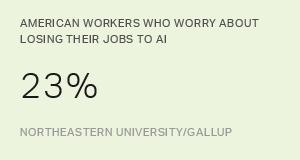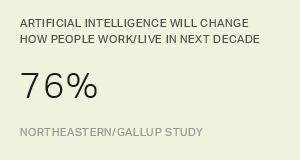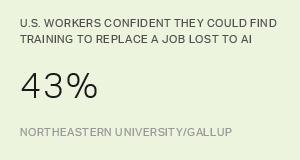Story Highlights
- 58% in U.S. say new technology is the greater threat to jobs
- 23% of U.S. workers worry they may lose their jobs to technology
- 12% of workers worry they may lose their jobs to immigration
WASHINGTON, D.C. -- More than half of Americans (58%) say technology poses a greater threat to jobs in the U.S. over the next decade, while 42% see immigration and offshoring as the greater threat. Republicans, who see immigration and offshoring as roughly an equal threat as technology, are the only subgroup of Americans not to see technology as a greater threat.
| New technology | Immigration and offshoring | |||||||||||||||||||||||||||||||||||||||||||||||||||||||||||||||||||||||||||||||||||||||||||||||||||
|---|---|---|---|---|---|---|---|---|---|---|---|---|---|---|---|---|---|---|---|---|---|---|---|---|---|---|---|---|---|---|---|---|---|---|---|---|---|---|---|---|---|---|---|---|---|---|---|---|---|---|---|---|---|---|---|---|---|---|---|---|---|---|---|---|---|---|---|---|---|---|---|---|---|---|---|---|---|---|---|---|---|---|---|---|---|---|---|---|---|---|---|---|---|---|---|---|---|---|---|---|
| % | % | |||||||||||||||||||||||||||||||||||||||||||||||||||||||||||||||||||||||||||||||||||||||||||||||||||
| All Americans | 58 | 42 | ||||||||||||||||||||||||||||||||||||||||||||||||||||||||||||||||||||||||||||||||||||||||||||||||||
| Age | ||||||||||||||||||||||||||||||||||||||||||||||||||||||||||||||||||||||||||||||||||||||||||||||||||||
| 18-35 | 61 | 39 | ||||||||||||||||||||||||||||||||||||||||||||||||||||||||||||||||||||||||||||||||||||||||||||||||||
| 36-50 | 57 | 43 | ||||||||||||||||||||||||||||||||||||||||||||||||||||||||||||||||||||||||||||||||||||||||||||||||||
| 51-65 | 57 | 43 | ||||||||||||||||||||||||||||||||||||||||||||||||||||||||||||||||||||||||||||||||||||||||||||||||||
| Education | ||||||||||||||||||||||||||||||||||||||||||||||||||||||||||||||||||||||||||||||||||||||||||||||||||||
| Less than a bachelor's degree | 57 | 43 | ||||||||||||||||||||||||||||||||||||||||||||||||||||||||||||||||||||||||||||||||||||||||||||||||||
| Bachelor's degree or higher | 61 | 39 | ||||||||||||||||||||||||||||||||||||||||||||||||||||||||||||||||||||||||||||||||||||||||||||||||||
| Job type | ||||||||||||||||||||||||||||||||||||||||||||||||||||||||||||||||||||||||||||||||||||||||||||||||||||
| White collar | 62 | 38 | ||||||||||||||||||||||||||||||||||||||||||||||||||||||||||||||||||||||||||||||||||||||||||||||||||
| Blue collar | 59 | 41 | ||||||||||||||||||||||||||||||||||||||||||||||||||||||||||||||||||||||||||||||||||||||||||||||||||
| Political party affiliation | ||||||||||||||||||||||||||||||||||||||||||||||||||||||||||||||||||||||||||||||||||||||||||||||||||||
| Republican | 48 | 52 | ||||||||||||||||||||||||||||||||||||||||||||||||||||||||||||||||||||||||||||||||||||||||||||||||||
| Independent | 57 | 43 | ||||||||||||||||||||||||||||||||||||||||||||||||||||||||||||||||||||||||||||||||||||||||||||||||||
| Democrat | 67 | 33 | ||||||||||||||||||||||||||||||||||||||||||||||||||||||||||||||||||||||||||||||||||||||||||||||||||
| NORTHEASTERN UNIVERSITY/GALLUP SURVEY, SEPT. 15-OCT. 10, 2017 | ||||||||||||||||||||||||||||||||||||||||||||||||||||||||||||||||||||||||||||||||||||||||||||||||||||
These data come from a Northeastern University/Â鶹´«Ã½AV survey of Americans' attitudes toward artificial intelligence (AI) and its effect on their lives and work. The mail survey of 3,297 U.S. adults was conducted Sept. 15-Oct. 10, 2017. The data show Americans are largely positive about the impact AI will have, but still expect it to cost jobs, with 73% of Americans predicting that AI will lead to a loss of more jobs than it creates.
The survey asked Americans to choose which they thought was the greater threat to U.S. jobs over the next decade, immigration and offshoring or new technology, automation, robots, or artificial intelligence. The question defined offshoring as jobs or companies moving overseas.
Although majorities across nearly all subgroups agree that new technology poses a greater risk to their jobs than immigration and offshoring does, Republicans consider the threat posed by technology (52%) to be roughly equal to that of immigration and offshoring (48%). Republicans' perceptions contrast sharply with Democrats', whose views strongly tilt toward believing new technology is the greater threat to jobs (67%) than is immigration and offshoring (33%).
U.S. Workers Twice as Likely to Worry About Losing Job to AI Than to Immigration
U.S. workers as well see a greater threat from new technology than from immigration and offshoring. Almost one in four American workers say they are very or somewhat worried about losing their own jobs to new technology, nearly twice as many as the 12% who say the same about immigration and offshoring. Levels of worry about these specific threats to American workers' jobs are higher than the 8% of U.S. adults who worry about being laid off in the next 12 months, in general.
How worried are you about an immigrant, that is, someone from another country taking your job, or are you not worried at all?
(Respondents who said they were somewhat or very worried)*
| New technology worry | Immigration worry | Technology minus immigration | ||||||||||||||||||||||||||||||||||||||||||||||||||||||||||||||||||||||||||||||||||||||||||||||||||
|---|---|---|---|---|---|---|---|---|---|---|---|---|---|---|---|---|---|---|---|---|---|---|---|---|---|---|---|---|---|---|---|---|---|---|---|---|---|---|---|---|---|---|---|---|---|---|---|---|---|---|---|---|---|---|---|---|---|---|---|---|---|---|---|---|---|---|---|---|---|---|---|---|---|---|---|---|---|---|---|---|---|---|---|---|---|---|---|---|---|---|---|---|---|---|---|---|---|---|---|---|
| % | % | pct. pts. | ||||||||||||||||||||||||||||||||||||||||||||||||||||||||||||||||||||||||||||||||||||||||||||||||||
| U.S. workers | 23 | 12 | 11 | |||||||||||||||||||||||||||||||||||||||||||||||||||||||||||||||||||||||||||||||||||||||||||||||||
| Age | ||||||||||||||||||||||||||||||||||||||||||||||||||||||||||||||||||||||||||||||||||||||||||||||||||||
| 18-35 | 25 | 13 | 12 | |||||||||||||||||||||||||||||||||||||||||||||||||||||||||||||||||||||||||||||||||||||||||||||||||
| 36-50 | 21 | 8 | 13 | |||||||||||||||||||||||||||||||||||||||||||||||||||||||||||||||||||||||||||||||||||||||||||||||||
| 51-65 | 27 | 15 | 12 | |||||||||||||||||||||||||||||||||||||||||||||||||||||||||||||||||||||||||||||||||||||||||||||||||
| Education | ||||||||||||||||||||||||||||||||||||||||||||||||||||||||||||||||||||||||||||||||||||||||||||||||||||
| Less than a bachelor's degree | 28 | 15 | 13 | |||||||||||||||||||||||||||||||||||||||||||||||||||||||||||||||||||||||||||||||||||||||||||||||||
| Bachelor's degree or higher | 15 | 7 | 8 | |||||||||||||||||||||||||||||||||||||||||||||||||||||||||||||||||||||||||||||||||||||||||||||||||
| Job type | ||||||||||||||||||||||||||||||||||||||||||||||||||||||||||||||||||||||||||||||||||||||||||||||||||||
| White collar | 19 | 9 | 10 | |||||||||||||||||||||||||||||||||||||||||||||||||||||||||||||||||||||||||||||||||||||||||||||||||
| Blue collar | 26 | 17 | 9 | |||||||||||||||||||||||||||||||||||||||||||||||||||||||||||||||||||||||||||||||||||||||||||||||||
| Political party affiliation | ||||||||||||||||||||||||||||||||||||||||||||||||||||||||||||||||||||||||||||||||||||||||||||||||||||
| Republican | 19 | 17 | 2 | |||||||||||||||||||||||||||||||||||||||||||||||||||||||||||||||||||||||||||||||||||||||||||||||||
| Independent | 27 | 13 | 14 | |||||||||||||||||||||||||||||||||||||||||||||||||||||||||||||||||||||||||||||||||||||||||||||||||
| Democrat | 23 | 9 | 14 | |||||||||||||||||||||||||||||||||||||||||||||||||||||||||||||||||||||||||||||||||||||||||||||||||
| *Among employed Americans | ||||||||||||||||||||||||||||||||||||||||||||||||||||||||||||||||||||||||||||||||||||||||||||||||||||
| NORTHEASTERN UNIVERSITY/GALLUP SURVEY, SEPT. 15-OCT. 10, 2017 | ||||||||||||||||||||||||||||||||||||||||||||||||||||||||||||||||||||||||||||||||||||||||||||||||||||
For the most part, American workers' fear of losing their jobs to new technology versus to immigrants varies little by subgroup. However, the key exception is Republican workers, who worry about the two threats to their own jobs roughly equally -- 19% for new technology versus 17% for immigration. Among Democratic workers, nearly a quarter (23%) worry about losing their jobs to new technology compared with 9% who worry about the threat to their personal jobs posed by immigration.
Bottom Line
Americans largely perceive new technology as a greater threat to jobs in the U.S. over the next decade than immigration and offshoring. This view is supported by a recent Oxford study of the potential impact of the adoption of AI on the U.S. job market, which suggests as many as 47% of jobs are potentially at risk of elimination from this new technology. In contrast, estimates of the cost in American jobs from immigration and offshoring vary widely, with some reports suggesting these may create more jobs than they eliminate.
The risk posed by new technology to American jobs has been given little public attention by President Donald Trump's administration. U.S. Treasury Secretary Steven Mnuchin recently said that there was no need to worry about AI displacing American workers for a half century or more. Trump has been much more focused on the impact of immigration, based on the contention that immigrants take jobs away from Americans.
Whether the Trump administration is focused on the impact of AI on jobs, many others see it as particularly pressing. Nearly three-quarters of Americans (73%) say the adoption of AI will eliminate more jobs than it creates.
Read the full Northeastern/Â鶹´«Ã½AV report "Optimism and Anxiety: Views on the Impact of Artificial Intelligence and Higher Education's Response."
Survey Methods
Results for the Northeastern University-Â鶹´«Ã½AV survey on artificial intelligence are based on surveys conducted by mail from Sept. 15 to Oct. 10, 2017, with a random sample of 3,297 U.S. adults aged 18 and older. The survey package included an English and a Spanish survey to provide respondents with the flexibility to reply in their preferred language.
Â鶹´«Ã½AV selected the sample of U.S. residents using address-based sampling (ABS), a sampling technique used to select households from a list of all households on file with the United States Postal Service (USPS). Â鶹´«Ã½AV chooses respondents within the household at random based on which household member would have the next birthday. Â鶹´«Ã½AV used a series of postcard reminders to encourage participation in the survey.
Â鶹´«Ã½AV weighted the data to match national demographics of gender, age, education, race, Hispanic ethnicity, education and region.
All reported margins of sampling error include the computed design effects for weighting.
-For results based on the total sample of 3,297 U.S. adults, the margin of sampling error is ±2 percentage points at the 95% confidence level.
-For results based on the sample of 2,871 employed U.S. adults, the margin of sampling error is ±3 percentage points at the 95% confidence level.





